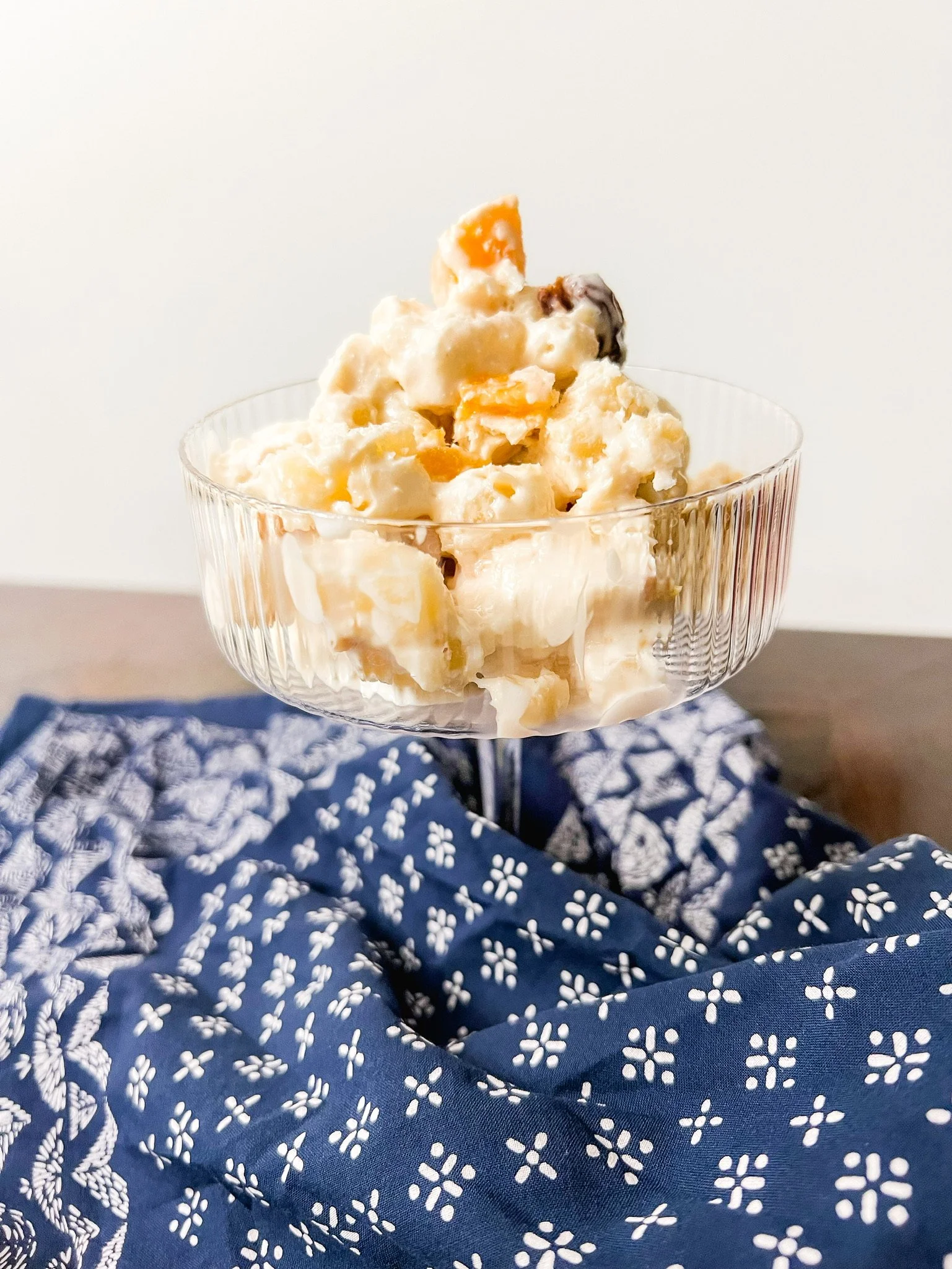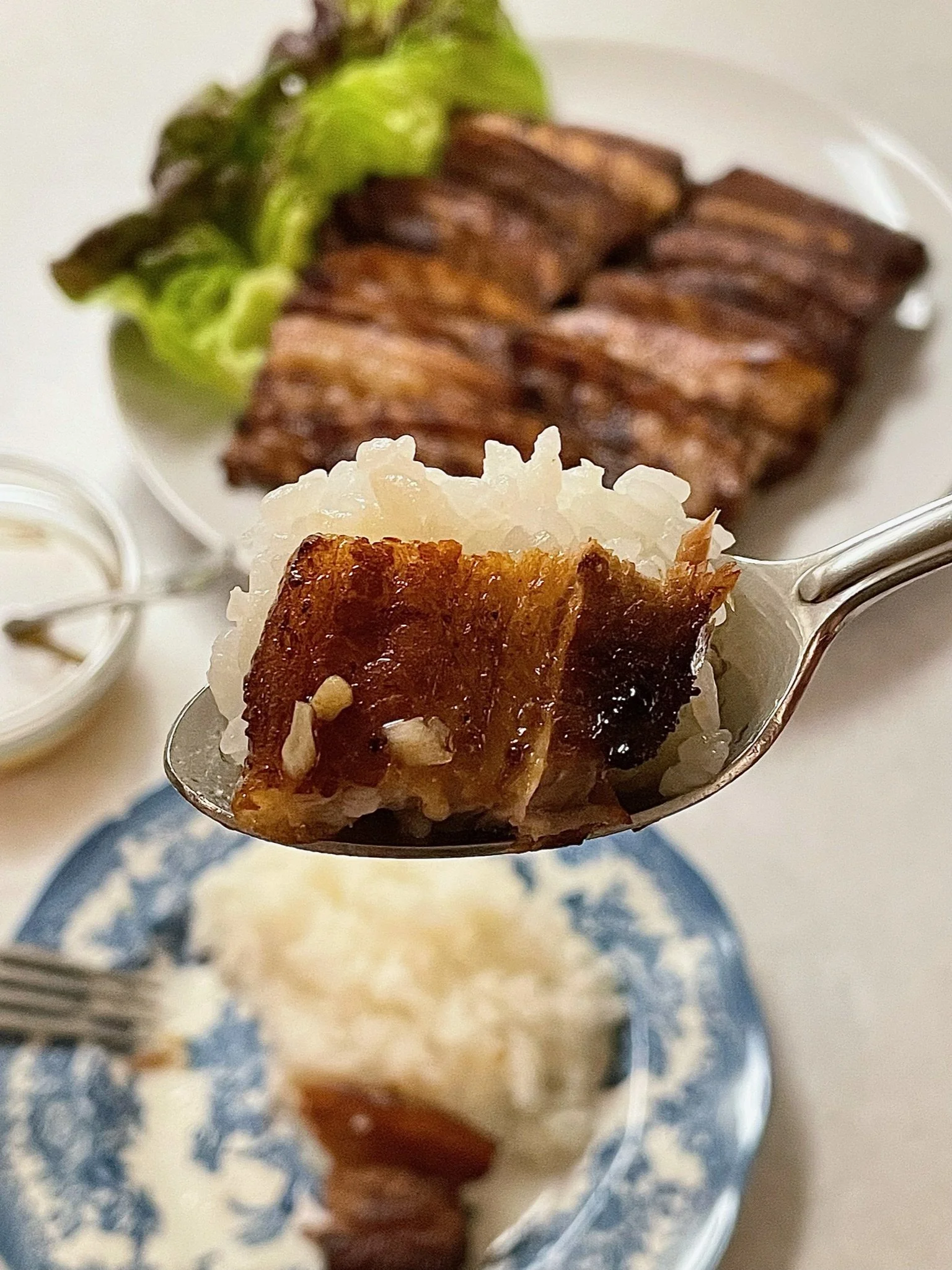Find a recipe.
Macaroni Fruit Salad
MACARONI FRUIT SALAD
“Your food is so weird!”
To many of us, that phrase and phrases similar to it evoke feelings of shame and self-consciousness about being othered. That’s what I got anytime I had to explain what was in my mother’s famous (to my siblings and me) macaroni fruit salad. You read that right, MACARONI FRUIT SALAD. This was the closest thing to stuffing, turkey, or pumpkin pie we had for the holidays. She made it for Noche Buena and New Year every single year.
Before you let your face scrunch up about the concept of a sweet macaroni dish, remember that rice pudding, tapioca pudding, and sweet polenta/grits exist. My mother was a child of the 50s, so not only were canned food and packaged pasta all the rage during that era, the Philippines’ cuisine is heavily influenced by the non-perishables brought to the country by Americans in times they aided us during war and times of attempting to colonize us. The thing that really makes people tell me this dish is weird before trying it is the secret ingredient my mother added, which is a few teaspoons of Best Foods mayonnaise for just a little tartness to round out the sweetness. I don’t know any other Filipino family that makes their macaroni salad this way, but it’s something of an upgrade to an ambrosia, mixed with the flavors of Magnolia Buko Salad Ice Cream.
I am my mother’s daughter, so I realized when it was too late that I didn’t really measure, but this is what’s in this dessert— I don’t add young coconut like she did and add extra pineapple because of my preference:
Macaroni (elbow or Ditalini) - a little less than one package
Nestlé Cream - one can
Condensed milk - about 1.5+ can (to taste)
Canned Fruit Salad - 1-2, drained
Canned Pineapple - 1, drained
Peanuts - coarsely crushed/chopped, about a couple hands full
Seedless Raisins - however much you want
It’s pretty much put everything in a large bowl, mix well, adjust to your liking, and then put in the freezer until ready to serve. Put in the fridge about 6-12 hours before serving (until soft enough to mix and scoop)
Stop telling people their food is weird.
With Love, Nori
Roasted Crab & Garlic Noodles
ROASTED CRAB 🦀 & GARLIC NOODLES
My dad’s sister immigrated to the Bay Area in the 70’s. Subsequently, the rest of his unmarried siblings followed suit through the years. Our parents stayed in the Philippines because they both had built successful businesses and we were all quite young. I do remember coming to the US to visit during our summer vacations to see our cousins and to also travel to different cities. A lot of our travels involved seeing the sights and of course, food.
An early food experience I remember during one of those vacations is going to Thanh Long in San Francisco. It was all about the Roasted Crab and Garlic Noodle. If you haven’t heard of Thanh Long, you may have heard of Crustacean – both are the Anh Family’s legacy. This experience stuck with me because we would eventually immigrate to the US and still frequent Thanh Long.
The Roasted Crab and Garlic Noodle is just such a magical combination. The sweetness of the Dungeness Crab paired back with the garlicky noodles is just a food memory that has stuck with my family, so much so that it has somehow made its way into our Noche Buena celebrations through the years. I can’t remember when it first appeared but I do have memories about trying to figure out how to make their noodles. There is something about it that sticks with you and later on, we figured out that it was Maggi (we think!). 😆
Let me just say that the recipe for Thanh Long’s Roasted Crab and Garlic Noodle is a closely guarded secret by the Anh family. No one really knows how to make their version but them so go visit them to get that experience. However, to make at home, you can definitely find a place to start by looking online. You’ve got many sources. Try them and make it your own. I will post my version in Stories and Highlights so you can check that out too.
Now you’ve seen @janieP00’s Galbi and my Roasted Crab and Garlic Noodle, neither dish is Filipino but are now part of our immigrant stories of Noche Buena. Do you have an adopted dish as well that is now a part of your Noche Buena? We’d love to hear from you.
♥️Tricia
Embutido
EMBUTIDO
In Spain and Portugal, Embutido typically refers to a cured sausage. In Philippine cuisine, it’s a meatloaf that represents the colonial influence of Spain and the US.In Spain and Portugal, Embutido typically refers to a cured sausage. In Philippine cuisine, it’s a meatloaf that represents the colonial influence of Spain and the US.
It has the smoky Spanish chorizo and the ubiquitous Spam that made its way to the Philippines via the American occupation during the war. It also includes olives, raisins and when used as a stuffing for Chicken Relleno, it can also include hard boiled eggs. All of the above is mixed with ground pork, shaped into a log, wrapped in foil and is steamed or baked.It has the smoky Spanish chorizo and the ubiquitous Spam that made its way to the Philippines via the American occupation during the war. It also includes olives, raisins and when used as a stuffing for Chicken Relleno, it can also include hard boiled eggs. All of the above is mixed with ground pork, shaped into a log, wrapped in foil and is steamed or baked.
In my family, Embutido signifies the holidays. My mom would make quite a few for us to eat and also gift to Family and friends. After moving away from home, I would always vie to get a loaf or two to take home.In my family, Embutido signifies the holidays. My mom would make quite a few for us to eat and also gift to Family and friends. After moving away from home, I would always vie to get a loaf or two to take home.
For Noche Buena, often at the table to support our grazing way of eating, we have Jamon, Queso de Bola, Pandesal and Embutido perfect for the sandwich making that happens throughout the day.For Noche Buena, often at the table to support our grazing way of eating, we have Jamon, Queso de Bola, Pandesal and Embutido perfect for the sandwich making that happens throughout the day.
A must for my family is to eat Embutido hot – typically pan seared so it gets crispy edges. I know that there are some that eat this cold or room temperature but I love the texture it gets from pan searing. It’s amazing when it is drizzled with its pan drippings but also equally amazing with banana ketchup.A must for my family is to eat Embutido hot – typically pan seared so it gets crispy edges. I know that there are some that eat this cold or room temperature but I love the texture it gets from pan searing. It’s amazing when it is drizzled with its pan drippings but also equally amazing with banana ketchup.
Some of my favorite ways of eating Embutido:Some of my favorite ways of eating Embutido:
1 - EMBUTIDO SILOG – with Sinangag and a Fried Egg1 - EMBUTIDO SILOG – with Sinangag and a Fried Egg
2 - EMBUTIDO SANDO - with Pandesal, egg, a little kewpie and Maggi and of course, banana ketchup. Pair this with a cup of Tsokolate.2 - EMBUTIDO SANDO - with Pandesal, egg, a little kewpie and Maggi and of course, banana ketchup. Pair this with a cup of Tsokolate.
3 - EMBUTIDO FRIED RICE - with pan drippings over Scallion Fried Rice3 - EMBUTIDO FRIED RICE - with pan drippings over Scallion Fried Rice
♥️Tricia
Galbi
GALBI
Cooking did not come naturally to my mom’s side of the family. In the Philippines, the family had a cook who prepared all their meals. None of them learned how to cook until they immigrated to the US. To this day, my mom barely cooks; if she does, it’s as minimal as possible. When galbi was introduced to our family gatherings many moons ago, it was something my mom & any one of my time-strapped family members could easily prepare, thus becoming a mainstay at the table of every family gathering.
I’m not exactly sure how or when galbi was first introduced to us. The Bay Area is a melting pot so it’s not far-fetched to believe that it was introduced by someone’s coworker or by going out to eat. I suspect it was my aunt who started it—she was always out “gallivanting” according to my Grandma & the one that cooks the most out of the siblings. When she learned & shared how easy it was to make, the rest is history. As simple as it was, my mom always had a million things on her plate so sometimes I would take over the prep duties. All it required was taking the short ribs out of the packets, placing them into a plastic bag, dumping jarred marinade into the bag & shoving it into the fridge until it was time to cook. We would line a baking sheet with foil for easy clean up & bake until the meat was nicely caramelized.
Instead of using the jarred marinade, I wanted to try to make it from scratch. I took a little bit of creative license & subbed @sibeihosibeiho sambal since I didn’t have gochujang. You can probably decipher all the ingredients from the picture—just process them all together until smooth, pour over the short ribs & marinate overnight. The next day, just grill & enjoy. Again, this isn’t a traditional Noche Buena dish, but it’s been a part of my food memories for so long. This also serves as a reminder that while it is important to preserve traditions, it’s also okay to throw something new into the mix & make some new, delicious memories in the process.
@nomnom_nori & @triciasanmateo are going to continue the series by sharing their Noche Buena memories in the coming weeks. In the meantime, stay cozy and cook something delicious!
🖤Jane
Inihaw na Liempo
INIHAW NA LIEMPO
For as long as I can remember, my family always had some kind of inihaw at every gathering. One favorite was inihaw na liempo, so naturally it would appear at the Noche Buena spread. Inihaw na liempo is ubiquitous in the Philippines where pork is king. It’s an equalizer—rich or poor, everyone loves it. I distinctly remember eating a piece that just came off the charcoal grill: it had some serious char & had the perfect balance of crisp & chewy textures, of salt & acid. On its own, it was already delicious but could be enhanced with a dunk in some sinamak or toyomansi.
Preparation for this dish is simple: you marinate pork belly & you grill it. When I was chatting with family members about how the marinade was prepared, I received a few variations: with soy, with salt, with vinegar, with calamansi. The basics include some sort of acid, some form of salt, garlic & pepper with varying ratios of each ingredient. In short, everyone has their own way of doing it so I followed suit.
I like liempo more acid forward so I do a 2:1 ratio of acid to salt. In this case, I used sugarcane vinegar and tamari. Sugarcane vinegar, native to the Ilocos region of the Philippines, is reminiscent of sherry vinegar or apple cider vinegar. Then I added crushed garlic cloves, black pepper & liempo slices. Marination time varies, but anywhere between 6-8 hours works. Depending on thickness of the slices, the cook time will vary. On my stovetop grill, it usually takes only a few minutes on each side before they’re ready to be enjoyed with rice & sawsawan (sinamak from @magnapdx) of choice.
Having to think & dig & write about this has brought back so many happy memories of me celebrating the Advent Season with my family both in the Philippines & back in California. It’s such a simple dish, but cooking it makes me feel a little closer to them at a time when it’s not so simple to just catch a flight to see them. Hopefully, I’ll be able to see them soon, but until then I’ll be cooking for comfort and creating my own Noche Buena memories with my little family here.
More soon. In the meantime, we’d love to hear about some dishes you make during the holiday season!
🖤Jane





